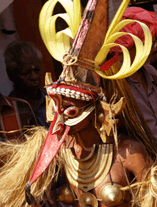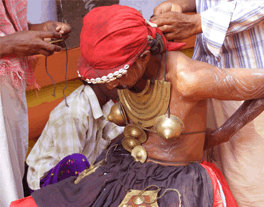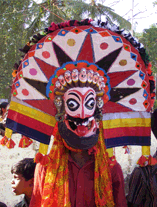| |
What is folk expression group
In 2003 vayali approached some folklore experts and under their guidance vayali folk expression group came into existence .folk expression group is an attempt by a group of youngsters to revive their dying folk art forms.
In first stage, we started collecting information from the elderly people of the village pertaining to folk dances and songs. After some time, organization faced some financial crisis to continue its work of documenting folk expression forms of valluvanad. To come out of this, we decided to perform these Valluvanadian art forms and it became a major and vital source of revenue for functioning of vayali. And revenue from performances were also used in supporting elderly people of village who assisted us in our initiative by supplying us requisite information pertaining to their respective communities.
We got connected with a few institution who looks at our efforts as a responsible initiative and some tourism companies stressing on ‘responsible tourism’ joint hands with us .through them we are getting domestic as well as international tourists. In this partnership of responsible tourism ,we take the visitors to local people where they can experience their rich culture in the form of dance ,songs and festivals. Through this “partnership of responsible tourism “local people are getting some recognition for their heritage as well as some income to lead a better life .And, now this folk expression group, slowly but steadily, is excelling in almost all valluvanadian art forms be it kudachozhi, kinnankali or chavittukali.
Our folk expression team meets regularly for rehearsal as well as to discuss future strategy. major objective behind formation of this group is to tap the the potential of youngsters of the village for the preservation of our more than 2000 years old heritage .we believe that anything can be achieved if youths are involved in that action directly.Youth are untapped reservoir of energy if this reservoir is used for revolutionary changes ,dreams will be materialized.
  
Need for vayali folk expression group
In this era of globalization and industrialization people are migrating to big cities and even to other and more industrialized countries. And ,there is no one to carry forward their cultural legacy in original place. Cultural landscape on the banks of river nila from palakkaad to malapuram, which took more than 2000 years to be so immensely rich that it has huge diversity in dance forms, songs, rituals and festival etc. In this small belt along nila we see a richness which is unique in different ways.
An important part of cultural landscape of nila is various folk expression forms of different communities. Vayali folk expression group came into existence for preservation of these endangered expression art forms. Since, folk knowledge systems are performed and practiced traditionally and transmitted to next generation orally through the gradual method of performing it. Folk art forms are different from those of classical in the manner ,these expression forms are learnt unconsciously through frequent exposure to such folk expression forms. But these precious indigenous knowledge, which evolved over centuries ;will be transmitted to next generation only when young generation will be interested in learning it. But young generation is moving away from their culture and values, and because of these the ‘LINK’ which is requisite to transfer the legacy from one generation to other ,is missing.
So,vayali folk expression team is just to bridge that gap ,which is not letting THE LEGACY TRANSFER happen. So, vayali team decided to learn as much as possible of these art forms before they disappear. Elderly people are masters of this heritage which they inherited from their forefathers,after them nobody will be able to revive them. and, this folk culture of valluvanad will be extinct. Just like dianosaurs did and perhaps for coming generations we will only have some museums on the name of these art forms. So, in first stage all information pertaining to these art forms collected from local elderly people and need to document it ,was felt.In second stage group started imparting knowledge on folklore ,they had gained from locals to interested youngsters.Our group aims at creating opportunities where the young people can learn and see their traditional expression forms. co-ordinator of vayali,Mr. vinod nambiar says,` `we never take performers looking at their talent but interest to learn these art forms. ”he also tells that once a viewer asked him for vayali performers,``don’t they get bored with the same stuff again and again.” he replied,`` that’s what we call INTEREST.they are unlike other performers who perform and leave it once the show is over. We take that into our heart and each of us would love to sing that again and again”
An indispensable part of Vayali is our folk expression group, through which we showcase the different art forms of Valluvanad like darika-wadham,kala-kali,chavittukali and kudachozhi etc. The exclusivity of Vayali’s folk expression group lies in the fact that even today we use the traditional material for making costumes and make-up of our artists. Thus, this group of ours is a reflection of not just the rich cultural heritage of Valluvanad but also of its resourcefulness and hitherto hidden talent.
Some of the major dance forms performed by the folk expression group are:-
1. Chavittukali: Rather than being a ritualistic dance form, this is a game played during the goddess Kali temple festival. There are two kinds of chavittukali ------ aankali, which is played exclusively by men and penkali, which witnesses the participation of both men & women. The participants arrange themselves in a circle, the two rival groups facing each other and respond to each other through songs. The beauty of this special kind of art form lies in its simplicity; the participants don’t need any special costume! They wear simple ordinary clothes and it is the feeling of mutual bonhomie that imparts colours to the setting.
2. Mudiyattam: This is a women-only dance, performed by the ladies of the Pulaya & Paraya communities. This is essentially performed to pleasethe angst-ridden goddess Kali. The myth associated with this dance is that after goddess Kali killed the asuran ‘Darika’ (also known as Mahishasur), she waved her long, black hair in air to perform a destructive dance. Traditional Paraya community instruments like marram, chenda and kurum kuzhal are used in the performance.
3. Darika-wadham: this is the most popular of all dance forms. It is the depiction of the ferocious war between goddess Kali and the demon ‘Darika’. It is believed that the demon darika wrecked havoc all over earth and heaven. The Gods (‘Devas’), after failing successively in defeating the demon approached Lord Brahma who told that it is only goddess Bhagwati who can slay the demon darika. Acting upon Lord Brahma’s advise, all the ‘devas’ contributed a small fraction of their power to give birth to a girl who, Bhagwati, was the embodiment of goddess Bhagwati herself. She stayed in a dark cave for 13 days because of which her complexion turned black and she was given the name of Kali. Kali battled with darika and freed the earth from the shackles of evil.
This dance form is performed in the temples of goddess Kali. The costumes and make-up are audiences’ delight. The head gear is mad of bamboo and palm leaves, painted with traditional, organic color. Sandal paste, turmeric paste, rice paste and kumkumam are used for the make up of Darika while goddess Kali’s face is smeared with black colour. Chilamb(a heavy brass ornament for ankles),annillam(a set of traditional ornaments adorned on chest and ear)and aramani(a kind of traditional waistband which makes sound on movement) are the ornaments used.
4. Kinnamkali: this dance form is associated with the most popular harvest festival of Kerala, ‘Onam’, which is celebrated in the memory of the great ruler Mahabali. This dance is performed by both men and women using nothing but bamboo sticks. While women wear the traditional white Kerala sarees, the men wear a white ‘mund’ (dhoti).
5. Kalakali: This is an agriculture based dance form of the Pulaya community to show the farmer’s gratitude towards all those natural factors, sunlight, rain, cattles etc which contribute to the farmer’s good harvest. In Kerala, the bullock is believed to be the symbol of agriculture; a good ‘kala’ (bull) leads to an exceptional harvest.
Farmers make ‘kalas’ of bamboo, and paddy grass and its head is made of the Muruk tree’s wood. The farmers hold these artificial bullocks on their shoulders, thus expressing their thankfulness towards them for working tirelessly for the farmers the whole year round.
6. Malavazhiattam and Maani: This is a dance form devoted to Goddess Malavazhy, who resides in the mountains. She is the goddess of paady harvest and is worshipped along the banks of river Nila. It is believed that whenever her sons need her, she descends and solves all their miseries. Eulogies are sung all night long in praise of the goddess.
Maani is goddess Malavzhy’s brother, and is comic in nature whose anecdotes, jokes and tales of wit are popular among the village folk. People dressed as Malavazhy and Maani sing and dance to the tunes of instruments like marram, chend and kurum kuzhal throughout the night.
7. Manglamkali: This is a tribal dance form of northern Kerala and is an after-marriage ritual. Manglamkali performers go to any and every house which has witnessed a wedding to wish the newly- weds a happy & prosperous life. They wear traditional costumes and a head gear made of areca nut leaves. They use a single instrument called ‘tudi’ and sings songs for the newly-wed couple.
8. Mundian maukan chatan: This dance form is devoted to Lord Shiva and his consort goddess Parvati. They are known as ‘Mukan chatan’ and ‘Mundian’ respectively, among the Paraya community. Performers dressed as Lord Shiva and goddess Parvati visit all houses and bless the people n behalf of the Gods. They receive money and foodgrains as offerings.
To dress as ‘mundian’, ornaments like annilam, aramani (waistband) and chilamb (heavy anklet) are adorned, shawl is draped and sandalwood paste is applied on the face. ‘Mukan chatan’s’ costume include a round head gear made of bamboo and covered with red, white and black colored strips of cloth. A special garland, called kunguma poo is worn by the performers.
9. Kudachozhi: this dance form is a part of the temple festival culture of Valluvanad ans is performed after the harvest. The performers called ‘chozhis’ perform this dance with a ‘kuda’ (umbrella), which represents plentiful rain and hence the name ‘kudachozhi’. ������
������������������������The chozhis dance in a circle to the tunes of folk songs and wave a ‘kuda’ and ‘visari’ (fan) in the air. The fan is made of palm leaf and bamboo. The performers wear a white mund and tie a white cloth to their waist.
Vayali folk expression group is creating awareness among young generation and imparting knowledge of folk arts through open space performance, seminars, symposiams etc.Through this exercise youngsters will come close to their folk art forms.As a part of this exercise the group has organizes some workshops and interactive sessions in some of the educational institutions near by,in which young minds are not only told about art forms but an opportunity to play those instruments is also given in it. So that ,they could actually enjoy the sessions. We believe that to get young minds involved in folk art forms,first we need to understand what they want or what would stimulate them to learn these art forms. So, we are trying to find some more innovative ways to introduce folk art forms to youngsters. Preservation of these endangered art forms will contribute to the conservation of the river nila-the mother of these art forms and the source of inspiration for locals to perform these art forms. |
|



